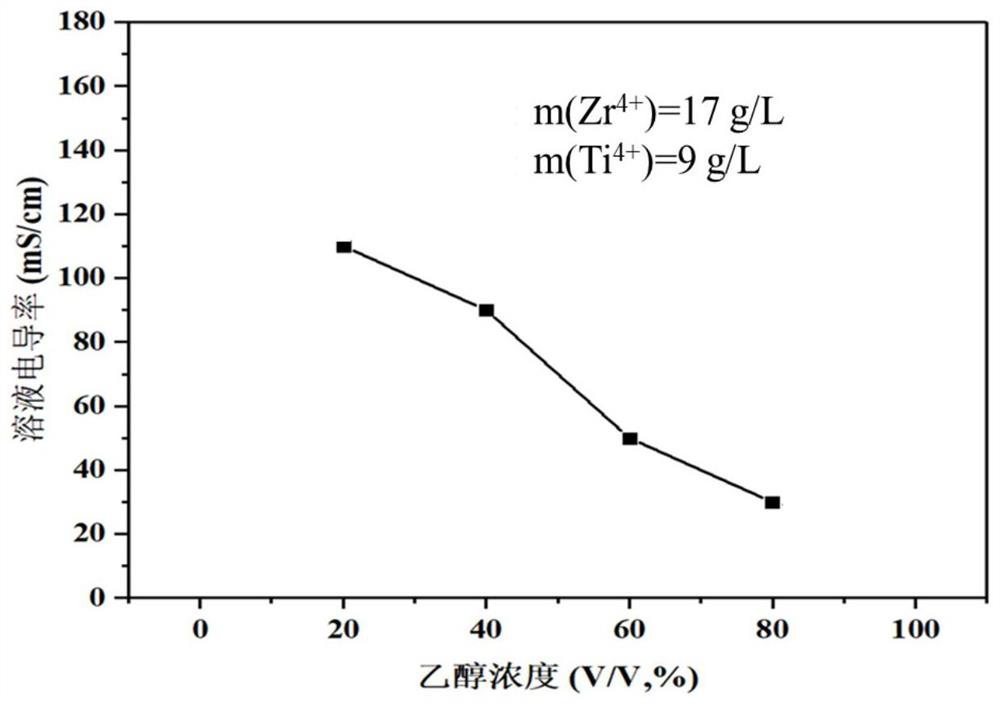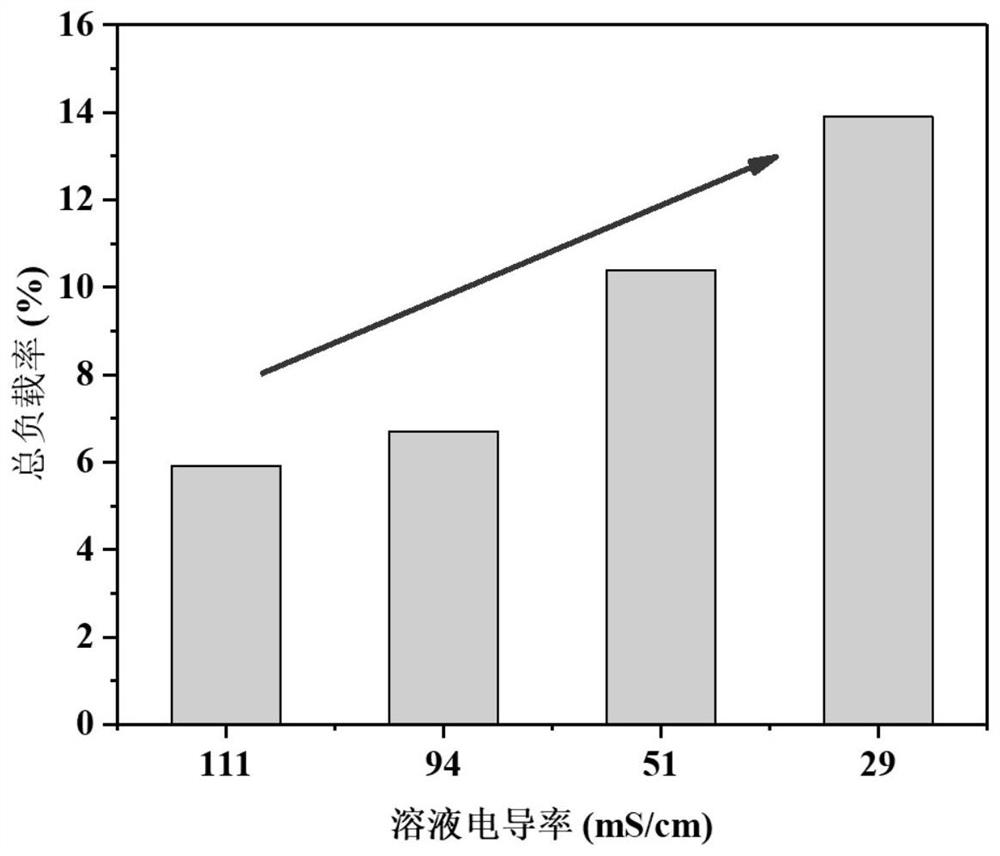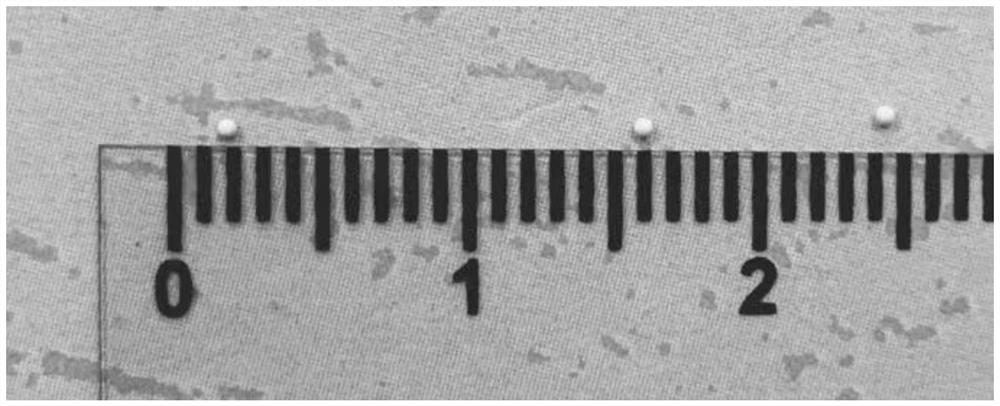Titanium-zirconium adsorbent as well as preparation method and application thereof
An adsorbent, titanium-zirconium technology, applied in the field of new-type titanium-zirconium adsorbent and its preparation, can solve the problems of complex process and long reaction cycle of titanium-zirconium adsorbent, achieve the effect of reducing reaction time, simple process and increasing ethanol concentration
- Summary
- Abstract
- Description
- Claims
- Application Information
AI Technical Summary
Problems solved by technology
Method used
Image
Examples
Embodiment 1
[0052] A method for preparing a novel titanium-zirconium adsorbent with simple procedures. The titanium-zirconium adsorbent is synthesized by an integral continuous loading method, and the specific steps are:
[0053] S1 First prepare the zirconium-titanium ion solution: add 250ml ethanol and 15ml hydrochloric acid to a 500ml beaker, put the beaker in an ice water bath, add 20ml TiCl while stirring constantly 4 Solution, stir until no smoke is produced and the solution turns pale yellow, then stop;
[0054] S2 then added 60g ZrOCl 2 ·8H 2 O (the molar ratio of titanium to zirconium is 1:1), add 20mL of deionized water, and continue to stir until completely dissolved. At this time, the concentration of titanium ions in the solution was 9g / L, the concentration of zirconium ions was 17g / L, the concentration of hydrochloric acid was 4.9%, the concentration of ethanol was 82.0%, and the conductivity of the measured solution was 29mS / cm.
Embodiment 2
[0056] The steps of this comparative example are basically the same as those in Example 1, keeping the concentration of titanium ions in the solution at 9 g / L, the concentration of zirconium ions at 17 g / L, the concentration of hydrochloric acid at 4.9%, and the molar ratio of titanium to zirconium at 1:1. The difference is: in step S1, ethanol, hydrochloric acid, TiCl 4 The addition amount of solution is respectively: 250ml ethanol, 21ml hydrochloric acid, 27ml TiCl 4 Solution; ZrOCl in step S2 2 ·8H 2 The addition amount of O is 82.6g, and deionized water is 122ml.
[0057] The concentration of ethanol was 59.5%, and the measured conductivity of the solution was 51 mS / cm.
Embodiment 3
[0066] The present embodiment is the method for the novel titanium-zirconium adsorbent prepared by the titanium-zirconium ion solution in Example 1, Example 2 and comparative examples A and B, comprising the following steps:
[0067] S3 Weigh 20g of strongly basic anion exchange resin D201 produced by Hangzhou Zhengguang Resin Factory, add it to the zirconium-titanium ion solution, set the temperature at 50°C, and stir at 180rpm under closed conditions for 12 hours;
[0068] S4 then, add 15g sodium hydroxide and 15g sodium chloride, 21g sodium hydroxide and 21g sodium chloride, 28g sodium hydroxide and 28g chlorine respectively in the solution of embodiment 1, embodiment 2 and comparative example A, B Sodium chloride, 56g sodium hydroxide and 56g sodium chloride, maintain the amount of adding sodium hydroxide and sodium chloride to be 5% by mass. Set the temperature at 50°C and stir at a speed of 180rpm for 3 hours; after the stirring is completed, the resin is filtered out an...
PUM
| Property | Measurement | Unit |
|---|---|---|
| diameter | aaaaa | aaaaa |
| particle diameter | aaaaa | aaaaa |
| electrical conductivity | aaaaa | aaaaa |
Abstract
Description
Claims
Application Information
 Login to View More
Login to View More - R&D
- Intellectual Property
- Life Sciences
- Materials
- Tech Scout
- Unparalleled Data Quality
- Higher Quality Content
- 60% Fewer Hallucinations
Browse by: Latest US Patents, China's latest patents, Technical Efficacy Thesaurus, Application Domain, Technology Topic, Popular Technical Reports.
© 2025 PatSnap. All rights reserved.Legal|Privacy policy|Modern Slavery Act Transparency Statement|Sitemap|About US| Contact US: help@patsnap.com



